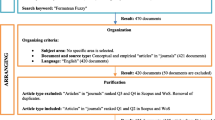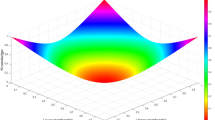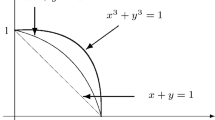Abstract
The fuzzy set (FS) theory has a significant role in the modelling of uncertainties. However, using the fuzzy set remain incapable in the modelling of the problems, when the decision-makers do not have the same opinion about the membership degree of an element or a decision-maker has different opinion related to membership degree of an element. To cope with this problem, the concept of a hesitant fuzzy set (HFS) was introduced by Torra and Narukawa. Recently, many generalizations of the FSs have been worked by researchers. One of them is type-2 fuzzy set (T2FS) and this set is an important role for dealing with problems involving uncertainty and linguistic variables. To take advantages of T2FSs and HFSs in the modelling of some problems into consideration, the concept of type-2 hesitant fuzzy sets (T2HFS) was defined. Another generalization of the FSs is spherical fuzzy set (SFS) and T-spherical fuzzy set (T-SFS) which is a generalization of SFS. In this research paper, to take advantages of T2HFSs and T-SFSs in the modelling of some problems into consideration, the concept of T-spherical type-2 hesitant fuzzy sets (T-ST2HFS) is defined and operations of union and intersection between two T-ST2HFSs. The basic idea behind of the set introduced in this paper is the assignment of T2HF elements for the components of a T-SFS. Then, a method is given to equalize lengths of the T2HF elements of which lengths are different from each other based on the optimistic and pessimistic approaches. The correlation coefficient is a very useful tool for dealing with some situations requiring the calculation of the relation between the two objects. With this motivation, correlation coefficients and weighted correlation coefficients are defined between proposed sets and some of their properties are obtained. Furthermore, a clustering analysis method, based on the put forward correlation coefficient formula is presented. Finally, to tackle a problem involving clustering the alternatives for a firm that wants to invest with a large amount of money, an application of the proposed method is given.











Similar content being viewed by others
References
Akram M (2020) Decision making method based on spherical fuzzy graphs. In: Otay I (ed) Kahraman C. Spherical fuzzy sets book. Studies in fuzziness and soft computing. Springer, Berlin
Akram M, Saleem D, Al-Hawary T (2020a) Spherical fuzzy graphs with application to decision-making. Math Comput Appl 25(8):2–32. https://doi.org/10.3390/mca25010008
Akram M, Alsulami S, Khan A, Karaaslan F (2020b) Multi-criteria group decision-making using spherical fuzzy prioritized weighted aggregation operators. Int J Comput Int Syst 13(1):1429–1446
Ashraf S, Abdullah S, Mahmood T (2019a) Spherical fuzzy Dombi aggregation operators and their application in group decision making problems. J Amb Intel Hum Comput 11:2731–2749
Ashraf S, Abdullah S, Mahmood T, Ghani F, Mahmood T (2019b) Spherical fuzzy sets and their applications in multi-attribute decision making problems. J Intell Fuzzy Syst 36(3):2829–2844
Ashraf S, Abdullah S, Aslam M, Qias M, Kutbi MA (2019c) Spherical fuzzy sets and its representation of spherical fuzzy t-norms and t-conorms. J Intell Fuzzy Syst 36(6):6089–6102
Atanassov KT (1986) Intuitionistic fuzzy sets. Fuzzy Sets Syst 20(1):87–96
Bustince H, Burillo P (1995) Correlation of interval valued intuitionistic fuzzy sets. Fuzzy Set Syst 74:237–244
Chaneau JL, Gunaratne M, Altschaev AG (1987) An application o type-2 sets to decision making in engineering. In: Bezdek JC (ed) Analysis of fuzzy in formation-vol II: artificial intelligence and decision systems. CRC Press Inc, Boca Raton
Chen N, Xu Z, Xia M (2013a) Correlation coefficients of hesitant fuzzy sets and their applications to clustering analysis. Appl Math Modell 37(4):2197–2211
Chen N, Xu ZS, Xia MM (2013b) Interval-valued hesitant preference relations and their applications to group decision making. Knowl-Based Syst 37:528–540
Chen ZS, Yang Y, Wang XJ, Chin KS, Tsui KL (2019) Fostering linguistic decision-making under uncertainty: a proportional interval type-2 hesitant fuzzy TOPSIS approach based on Hamacher aggregation operators and andness optimization models. Inf Sci 500:229–258
Cuong B (2013) Picture fuzzy sets-first results. part 1. In: Seminar “Neuro-Fuzzy Systems with Applications”. Institute of Mathematics, Hanoi
Dubois D, Prade H (1980) Fuzzy sets and systems: theory and applications. Academic Press Inc, New York
Dumitrescu D (1977) A definition of an informational energy in fuzzy sets theory. Stud Univ Babes Bolvai Ser Math 2:57–59
Farhadinia B (2013) Information measures for hesitant fuzzy sets and interval-valued hesitant fuzzy sets. Inf Sci 240:129–144
Garg H, Munir M, Ullah K, Mahmood T, Jan N (2018) Algorithm for T-spherical fuzzy multi-attribute decision making based on improved interactive aggregation operators. Symmetry 10(12):670
Gerstenkorn T, Manko J (1991) Correlation of intuitionistic fuzzy sets. Fuzzy Sets Syst 44:39–43
Guleria A, Bajaj RK (2020) T-spherical fuzzy graphs: operations and applications in various selection process. Arab J Sci Eng 45:2177–2193
Gundogdu FK, Kahraman C (2019a) Spherical fuzzy sets and spherical fuzzy TOPSIS method. J Intell Fuzzy Syst 36(1):337–352
Gundogdu FK, Kahraman C (2019b) Spherical fuzzy sets and decision making applications. In: Kahraman C, Cebi S, Cevik Onar S, Oztaysi B, Tolga A, Sari I (eds) Intelligent and fuzzy techniques in big data analytics and decision making. INFUS 2019. Advances in intelligent systems and computing, vol 1029. Springer, Cham (2020)
Gundogdu, FK, Kahraman C, Onar SC, Oztaysi B (2019) Hospital location selection using spherical fuzzy TOPSIS. In: 2019 conference of the international fuzzy systems association and the European Society for Fuzzy Logic and Technology (EUSFLAT 2019). Atlantis Press
Feng L, Chuan-qiang F, Wei-he X (2018) Type-2 hesitant fuzzy sets. Fuzzy Inf Eng 10(2):249–259
Hagras H (2004) A hierarchical type-2 fuzzy logic control architecture for autonomous mobile robots. IEEE Trans Fuzzy Syst 4(12):524–539
Huang J, You XY, Liu HC, Si SL (2019) New approach for quality function deployment based on proportional hesitant fuzzy linguistic term sets and prospect theory. Int J Prod Res 57(5):1283–1299
Hung WL, Yang MS (2004) Similarity measures between type-2 fuzzy sets. Int J Uncertain Fuzzy 12(6):827–841
Hwang CM, Yang MS, Hung WL, Stanley LE (2011) Similarity, inclusion and entropy measures between type-2 fuzzy sets based on the sugeno integral. Math Comput Model 53(9):1788–1797
Innocent P, John R (2002) Type 2 fuzzy diagnosis. IEEE Int Conf Fuzzy Syst 2:1326–1330
Innocent P, John R, Belton I, Finlay D (2001) Type 2 fuzzy representations of lung scans to predict pulmonary emboli. In: Proceedings of 2001 IFSA/NAFIPS joint conference, Vancouver, BC, Canada, Jul 2001, pp 1902–1907
John R (1996) Type-2 inferencing and community transport scheduling. In: Proceedings of 4th European Congress Intelligent Techniques Soft Computing, Aachen, Germany, 1996, pp 1369–1372
John R (1998) Type 2 fuzzy sets, an appraisal of theory and applications. Int J Uncertain Fuzzy 6(6):563–576
John RI, Innocent PR, Barnes MR (1997) Type-2 fuzzy sets and neuro-fuzzy clustering or radiographic tibia images. In: Proceedings of 6th international conference on fuzzy systems, Barcelona, Spain, 1997, pp 1375–1380
Karaaslan F, Ozlu S (2020) Correlation coefficients of dual type2 hesitant fuzzy sets and their applications in clustering analysis. Int J Intell Syst 35:1200–1229
Karnik N, Mendel J (1999) Applications of type-2 fuzzy logic systems to forecasting of time series. Inf Sci 120:89–111
Liang Q, Mendel J (2001) MPEG VBR video traffic modeling and classification using fuzzy techniques. IEEE Trans Fuzzy Syst 1(9):183–193
Liao H, Xu Z (2013) A VIKOR-based method for hesitant fuzzy multi-criteria decision making. Springer, New York
Liao HC, Yang LY, Xu ZS (2018) Two new approaches based on ELECTRE II to solve the multiple criteria decision making problems with hesitant fuzzy linguistic term sets. Appl Soft Comput 63:223–234
Liu P, Khan Q, Mahmood T, Hassan N (2019) T-spherical fuzzy power muirhead mean operator based on novel operational laws and their application in multi-attribute group decision making. IEEE 7:22613–22632
Mahmood T, Ullah K, Khan Q, Jan N (2018) An approach towards decision making and medical diagnosis problems using the concept of spherical fuzzy sets. Neural Comput Appl 31:7041–7053
Mitchell HB (2006) Correlation coefficient for type-2 fuzzy sets. Wiley Period 21(2):143–153
Mizumoto M, Tanaka K (1976) Some properties of fuzzy sets of type-2. Inf Control 31:312–340
Mizumoto M, Tanaka K (1981) Fuzzy sets of type 2 under algebraic product and algebraic sum. Fuzzy Sets Syst 5:277–290
Mendel JM, John RB (2002) Type-2 fuzzy sets made simple. IEEE Trans Fuzzy Syst 10(2):117–127
Mendel J, Hani H, Sola HB, Herrera F (2014) Interval type-2 fuzzy sets are generalization of interval-valued fuzzy sets: toward a wider view on their relationship. IEEE Trans Fuzzy Syst 23(5):1876–1882
Munir M, Kalsoom H, Ullah K, Mahmood T, Chu YM (2020) T-Spherical Fuzzy Einstein Hybrid Aggregation Operators and Their Applications in Multi-Attribute decision making problems. Symmetry 12:365
Nieminen J (1977) On the algebraic structure of fuzzy sets of type-2. Kybernetica 13(4):261–273
Ozlu S, Karaaslan F (2020) Some distance measures for Type-2 hesitant fuzzy sets and their application to multi-criteria group decision making problems. Soft Comput 24:9965–9980
Peng DH, Gao CY, Gao ZF (2013) Generalized hesitant fuzzy synergetic weighted distance measures and their application to multiple criteria decisionmaking. Appl Math Modell 37:5837–5850
Peng JJ, Wang JQ, Wang J, Yang LJ, Chen XH (2015) An extension of ELECTRE to multi-criteria decision-making problems with multi-hesitant fuzzy sets. Inf Sci 307:113–126
Qian G, Wang H, Feng X (2013) Generalized hesitant fuzzy sets and their application in decision support system. Knowl Based Syst 37:357–365
Quek SG, Selvachandran G, Munir M, Mahmood T, Ullah K, Son LH, Thong PH, Kumar R, Priyadarshini I (2019) Multi-attribute multi-perception decision-making based on generalized T-spherical fuzzy weighted aggregation operators on neutrosophic sets. Mathematics 7:780
Rodriguez RM, Martinez L, Herrera F (2014a) Hesitant fuzzy linguistic term sets for decision making. IEEE Trans Fuzzy Syst 20:109–119
Rodriguez RM, Martinez L, Torra V, Xu ZS, Herrera F (2014b) Hesitant fuzzy sets: state of the art and future directions. Int J Intell Syst 29:495–524
Sahin R, Liu P (2017) Correlation coefficients of single valued neutrosophic hesitant fuzzy sets and their applications in decision making. Neural Comput Appl 28:1387–1395
Sellak H, Ouhbi B, Frikh B (2018) A knowledge-based outranking approach for multi-criteria decision-making with hesitant fuzzy linguistic term sets. Appl Soft Comput 67:625–640
Singh P (2014) Some new distance measures for type-2 fuzzy sets and distance measure based ranking for group decision making problems. Front Comput Sci 8(5):741–752
Torra V (2010) Hesitant fuzzy sets. Int J Intell Syst 25:529–539
Torra V, Narukawa Y (2009) On hesitant fuzzy sets and decision. In:18th IEEE international conference on fuzzy systems. Jeju Island, Korea 2009:1378–1382
Ullah K, Mahmood T, Jan N (2014) Similarity measures for T-spherical fuzzy sets with applications in pattern recognition. Symmetry 10(6):193
Ullah K, Mahmood T, Jan N, Ali Z (2018) A note on geometric aggregation operators in T-spherical fuzzy environment and their applications in multi-attribute decision making. J Eng Appl Sci 37(2):75–86
Ullah K, Hassan N, Mahmood T, Jan N, Hassan M (2019) Evaluation of investment policy based on multi-attribute decision-making using interval valued T-spherical fuzzy aggregation operators. Symmetry 11(3):357
Ullah K, Mahmood T, Garg H (2020a) Evaluation of the performance of search and rescue robots using T-spherical fuzzy Hamacher aggregation operators. Int J Fuzzy Syst 22:570–582
Ullah K, Garg H, Mahmood T, Jan N, Ali Z (2020b) Correlation coefficients for T-spherical fuzzy sets and their applications in clustering and multi-attribute decision making. Soft Comput 24:1647–1659
Wang PZ (1983) Fuzzy set theory and applications. Shanghai Scientific and Technical Publishers, Shanghai
Wei CP, Ren ZL, Rodriguez RM (2014) A hesitant fuzzy linguistic TODIM method based on a score function. Int J Comput Intell Syst 8(4):701–712
Wu K (1996) Fuzzy interval control of mobile robots. Comput Electr Eng 22:211–229
Wu M, Chen T, Fan J (2020) Divergence measure of T-spherical fuzzy sets and its applications in pattern recognition. IEEE 8:10208–10221
Xu Z, Xia MM (2012) Hesitant fuzzy entropy and cross-entropy and their use in multiattribute decision making. Int J Intell Syst 27:799–822
Xu Z, Chen J, Wu J (2008) Clustering algorithm for intuitionistic fuzzy sets. Inf Sci 178(19):3775–3790
Yager RR (1980) Fuzzy subsets o type II in decisions. J Cybernet 10:137–159
Yager RR (2013a) Pythagorean fuzzy subsets. 2013 Joint IFSA world congress and NAFIPS annual meeting (IFSA-NAFIPS) (2013), pp 57-61
Yager RR (2013b) Pythagorean membership grades in multi-criteria decision making. IEEE Trans Fuzzy Syst 22(4):958–965
Yang MS, Lin DC (2009) On similarity and inclusion measures between type-2 fuzzy sets with an application to clustering. Comput Math Appl 57(6):896–907
Yang MS, Shih HM (2001) Cluster analysis based on fuzzy relations. Fuzzy Sets Syst 120(2):197–212
Yang Y, Chin KS, Ding H, Lv HX, Li YL (2019) Pythagorean fuzzy Bonferroni means based on T-norm and its dual T-conorm. Int J Int Syst 34(6):1303–1336
Ye J (2015) Multiple-attribute decision-making method under a single-valued neutrosophic hesitant fuzzy environment. J Intell Syst 24:23–36
Zadeh LA (1965) Fuzzy sets. Inform Comput 8:338–353
Zadeh LA (1975) The concept of a linguistic variable and its application to approximate reasoning-1. Inf Sci 8:199–249
Zeng S, Garg H, Munir M, Mahmood T, Hussain AA (2019) Multi-attribute decision making process with immediate probabilistic interactive averaging aggregation operators of T-spherical fuzzy sets and its application in the selection of solar cells. Energies 12(23):4436
Zhao H, Xu Z, Wang Z (2013) Intuitionistic fuzzy clustering algorithm based on Boolean matrix and association measure. Int J Inf Technol Decis Mak 12(1):95–118
Zhang XL, Xu ZS (2014) The TODIM analysis approach based on novel measured functions under hesitant fuzzy environment. Knowl Based Syst 61:48–58
Zhong X, Xu X (2020) Clustering-based method for large group decision making with hesitant fuzzy linguistic information: Integrating correlation and consensus. Appl Soft Comput 87:105973
Zhu B, Xu Z, Xia M (2012) Dual hesitant fuzzy sets. J Appl Math Article ID 879629:13
Author information
Authors and Affiliations
Corresponding author
Ethics declarations
Conflict of interest
The authors declare that they have no conflict of interest.
Additional information
Publisher's Note
Springer Nature remains neutral with regard to jurisdictional claims in published maps and institutional affiliations.
Rights and permissions
About this article
Cite this article
Özlü, Ş., Karaaslan, F. Correlation coefficient of T-spherical type-2 hesitant fuzzy sets and their applications in clustering analysis. J Ambient Intell Human Comput 13, 329–357 (2022). https://doi.org/10.1007/s12652-021-02904-8
Received:
Accepted:
Published:
Issue Date:
DOI: https://doi.org/10.1007/s12652-021-02904-8




